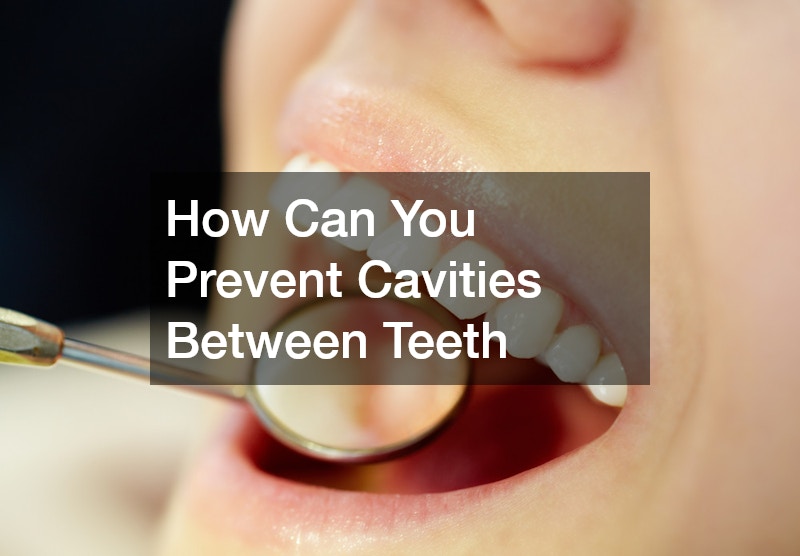What Your Dentist Does When You Have a Cavity Between Teeth
Cavities are among the most common dental problems, but when they develop between teeth, they can be especially difficult to detect and treat. These types of cavities, known as interproximal cavities, often go unnoticed until they become more severe. Understanding how they form, how your dentist detects them, and what treatment options are available can help you protect your oral health and prevent future decay.
What Causes Cavities Between Teeth
Plaque Buildup and Bacteria
Plaque is a sticky film of bacteria that constantly forms on your teeth. When plaque isn’t removed effectively, the bacteria produce acids that eat away at tooth enamel.
The tight spaces between teeth are especially vulnerable since plaque can easily accumulate where a toothbrush may not reach.
Diet and Sugar Consumption
Frequent consumption of sugary foods and drinks is a major contributor to cavities. The bacteria in your mouth feed on sugars, creating acid that breaks down enamel. Even “healthy” snacks like dried fruit or fruit juices can increase your risk if consumed often and not followed by proper cleaning.
Poor Oral Hygiene
Inadequate brushing and flossing allow plaque to remain between teeth, setting the stage for decay. Many people brush regularly but skip flossing, leaving hidden areas untreated. Your dentist often emphasizes flossing because it’s one of the best defenses against interproximal cavities.
Genetics and Predisposing Factors
Some people are more prone to cavities due to genetics. Factors such as tooth shape, enamel strength, and saliva composition can all influence how resistant your teeth are to decay. If your parents experienced frequent cavities, your dentist may recommend more frequent cleanings or preventive treatments.
How Does a Dentist Detect Cavities Between Teeth
Visual Examination
Your dentist begins with a thorough visual inspection. While small cavities between teeth aren’t always visible, surface changes like discoloration or roughness can provide early clues.
Dental X-Rays
X-rays are one of the most effective tools for spotting interproximal cavities. They allow your dentist to see decay hidden between teeth that the naked eye cannot detect. Bitewing X-rays, in particular, reveal the contact points between teeth where decay often begins.
Use of Dental Probes
During an exam, your dentist may gently use a dental explorer or probe to check for soft spots or sticky areas that indicate weakened enamel.
Patient Symptoms Reporting
Sometimes, patients notice sensitivity or discomfort when eating sweets or drinking cold beverages. Reporting these symptoms helps your dentist pinpoint potential issues early.
Technological Advancements in Detection
Modern dental practices use digital imaging and laser fluorescence devices to identify early-stage cavities more accurately. These tools allow your dentist to find decay before it becomes a larger problem, helping you preserve more of your natural tooth structure.
What Are the Treatment Options for Cavities Between Teeth
Dental Fillings
The most common treatment for small to moderate cavities is a dental filling. Your dentist removes the decayed area and fills the space with a restorative material to protect and restore the tooth’s structure.
Composite Resins
Composite resin fillings are tooth-colored and blend seamlessly with your natural teeth. They are often preferred for cavities between teeth because they provide both strength and aesthetics.
Inlays and Onlays
For larger cavities that don’t require a full crown, your dentist may recommend inlays or onlays. These custom restorations fit precisely within or over the affected area for added durability.
Dental Crowns
If a cavity has severely weakened a tooth, a crown may be necessary to restore its shape, strength, and function. Crowns completely cover the tooth, preventing further decay.
Root Canal Procedures
In cases where decay reaches the tooth’s pulp, a root canal may be required. Your dentist or endodontist removes the infected tissue, disinfects the area, and seals it to prevent reinfection.
How Can You Prevent Cavities Between Teeth
Effective Brushing Techniques
Brush at least twice a day using a fluoride toothpaste. Use gentle circular motions and pay attention to all surfaces, including along the gumline. Electric toothbrushes can help ensure a more consistent clean.
Importance of Flossing
Floss daily to remove plaque and food debris from between your teeth. Your dentist may recommend interdental brushes or water flossers if traditional flossing is difficult.
Regular Dental Check-Ups
Seeing your dentist every six months allows for early detection of cavities and professional cleaning to remove hardened plaque (tartar) that brushing alone can’t eliminate.
Dietary Adjustments
Limit sugary snacks and acidic beverages. Drink water throughout the day to rinse away food particles and keep your mouth hydrated.
Fluoride Treatments and Sealants
Fluoride strengthens enamel, making it more resistant to decay. Your dentist may suggest in-office fluoride applications or sealants to protect vulnerable areas.
What Are the Potential Complications If Cavities Between Teeth Are Left Untreated
Tooth Decay and Damage
If untreated, cavities will continue to grow, eventually compromising the tooth’s structure and leading to pain or fracture.
Gum Disease
Decay between teeth can irritate nearby gums, contributing to inflammation, bleeding, and eventual gum disease.
Infections and Abscesses
Bacteria from untreated cavities can spread to the tooth’s root or jawbone, causing painful abscesses that require urgent treatment.
Tooth Loss
Severe decay can lead to tooth loss, affecting your ability to chew and your overall oral alignment.
Impact on Overall Health
Oral infections can contribute to systemic health problems, including heart disease and diabetes complications. This is why your dentist emphasizes timely care and prevention.
Cavities between teeth may be hidden, but their impact can be serious if left untreated. Understanding the causes, detection methods, and treatment options can help you take proactive steps to protect your oral health. Regular visits to your dentist, combined with good hygiene and dietary habits, are the best defense against decay and the key to a lifelong healthy smile.



